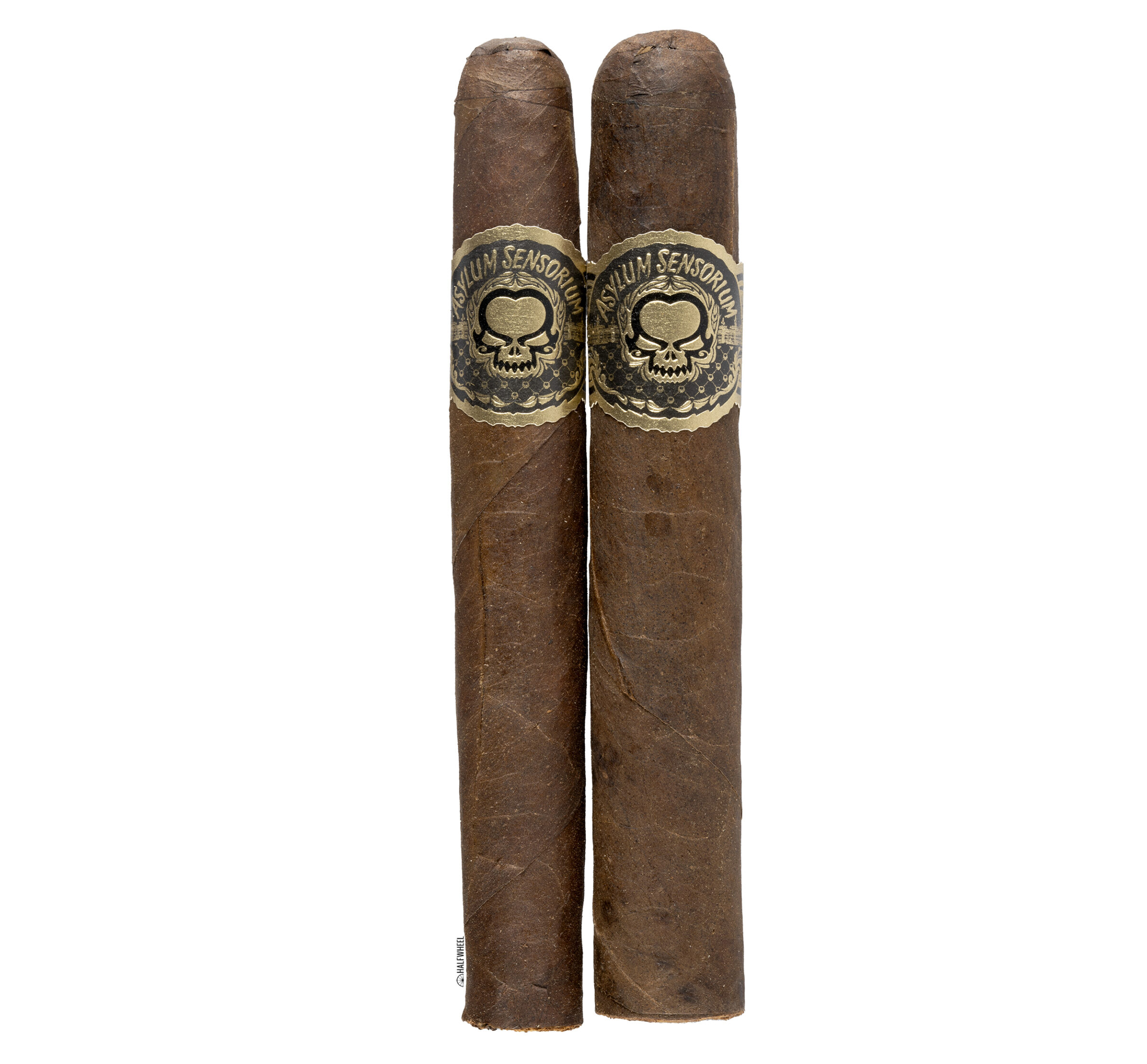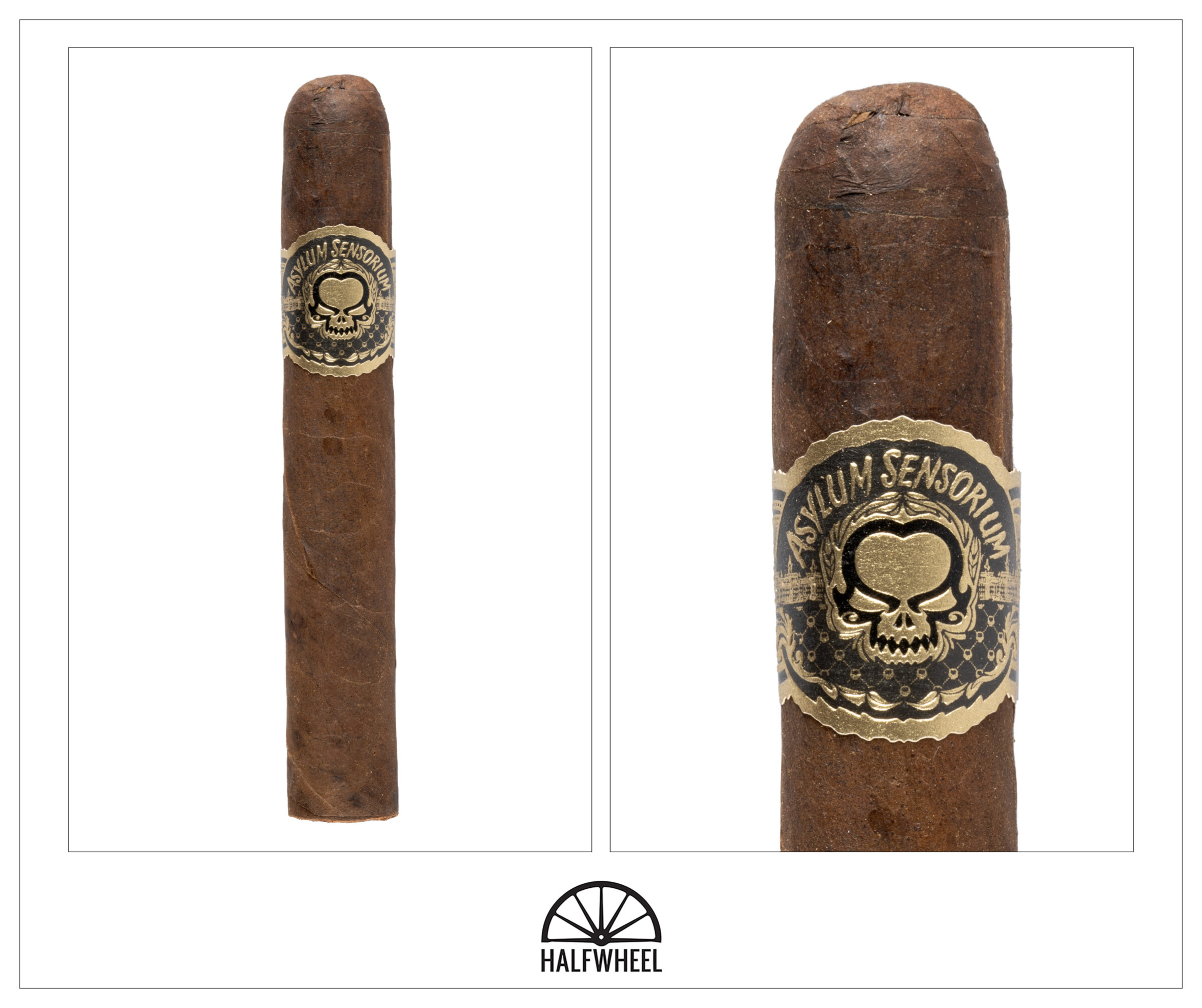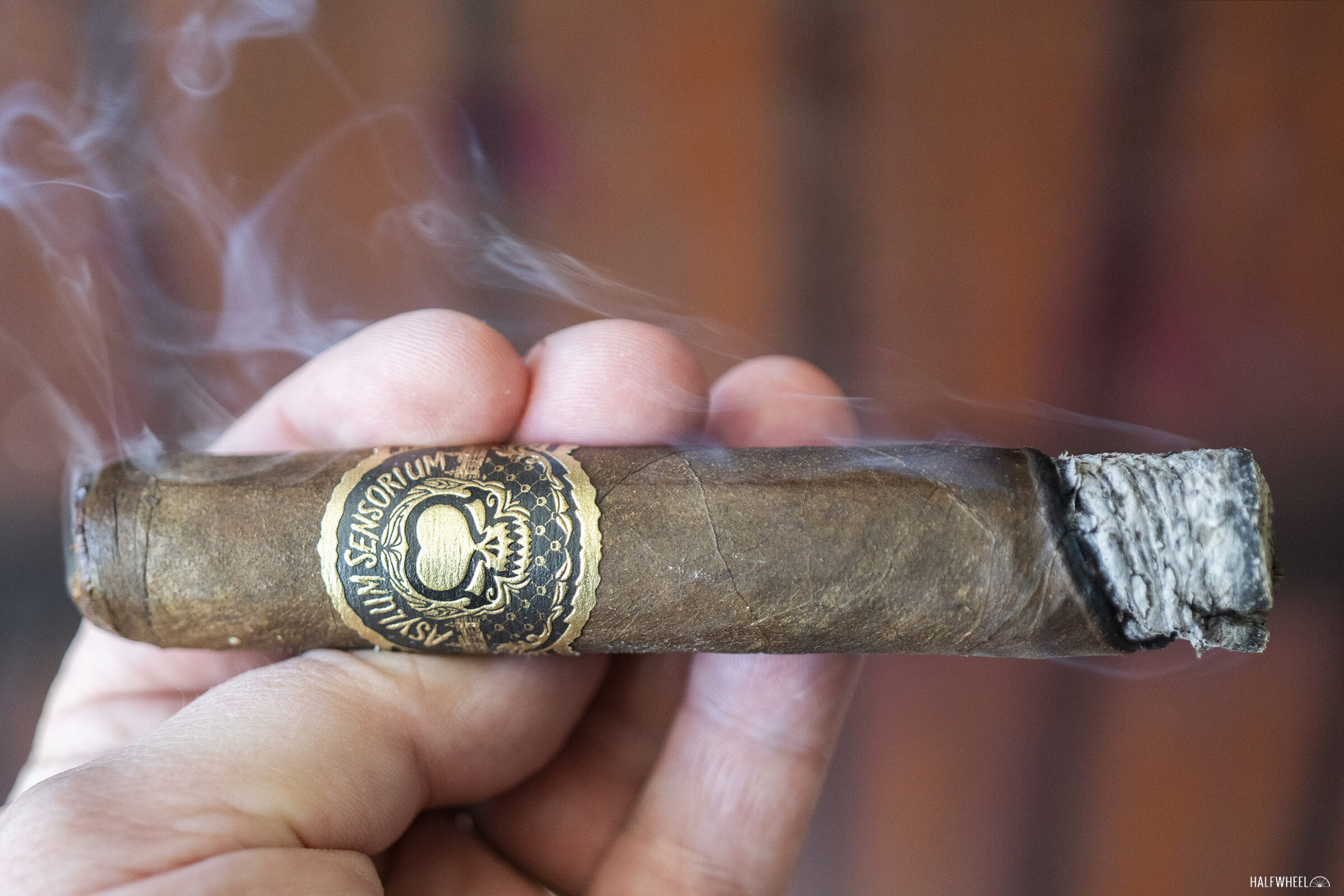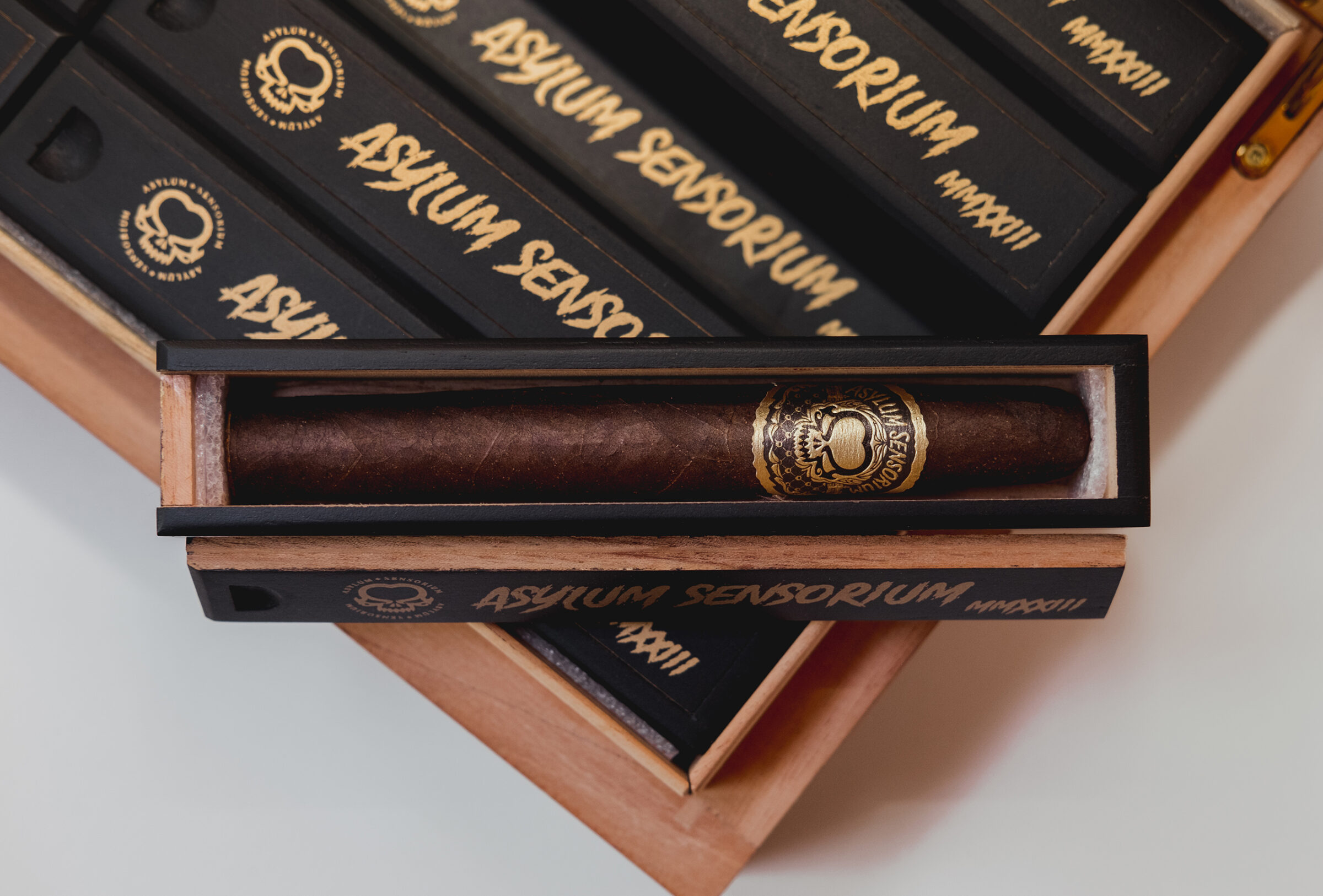When it debuted in 2012, Asylum was billed as a brand created to bring “a diversity of taste profiles and formats at very approachable prices” and has since become well-known for its larger ring gauge cigars. In the 10 years since that, Asylum has released a multitude of cigars, including a 9 x 90 behemoth that was originally made for April Fool’s Day.
In May, the company announced Sensorium, a two-vitola line composed of 100 percent Honduran tobacco, including corojo tobacco grown by the Eiroas in the Jamastran Valley. Perhaps the most interesting aspect of the new blend is that it includes a tobacco called Pinareño, a Cuban-seed tobacco not normally grown by the Eiroa family due in large part to its susceptibility to disease and the difficulty that comes with cultivating it.
“We used some first-generation Piñareno seed from Cuba, my father grew in Jamastran,” said Christian Eiroa, co-founder of Asylum, in a press release. “He has had this seed for decades, but had not grown it since 1979, when blue mold swept through Honduras in 1977. Any attempts to grow it in Honduras have yielded continuous losses of 25 – 40% on the field, due to its susceptibility to everything. Piñareno is truly the tastiest tobacco I have ever tasted, and I feel it is worth the sacrifice.”

Sensorium launched in two different sizes: the Asen 18 is rolled in the unique 11/18 perfecto vitola—which has been used for a number of CLE and Asylum releases—that measures 6 x 52 at its thickest point. The other vitola is the Asen 60, a 6 x 60 gordo. The cigars are priced at $50 and $60 each, respectively, and both cigars are packaged in individual coffins and sold in 20-count boxes. According to the company, 10,000 cigars of each vitola will be released every year.
Note: The following shows the various Asylum Sensorium vitolas. Some of these cigars may have been released after this post was originally published. The list was last updated on Aug. 17, 2023.

- Asylum Sensorium Asen 18 (6 1/4 x 52/60) — 5,00 Boxes of 20 (10,000 Total Cigars) — $50 (Box of 20, $1,000)
- Asylum Sensorium Asen 60 (6 x 60) — 5,00 Boxes of 20 (10,000 Total Cigars) — $60 (Box of 20, $1,200)
90
Overall Score
For years, I had a somewhat apathetic viewpoint of Honduran tobacco; sure, there were some excellent cigar releases that included Honduran leaves, but for the most part, that was where it ended. With releases like the Eiroa Jamastran 11/18 and the Eiroa The First 20 Years Diadema, the Eiroas were one of the main reasons I changed my mind in that regard, and the Asylum Sensorium Asen 60 is yet another example of a Honduran puro done well. Not only does the blend include a profile that shifts from cloves and powdery cocoa nibs to creamy cedar and rich cinnamon in the second half—as well as the addition of red pepper on the retrohale—but the construction was excellent overall, with only one cigar needing a couple of corrections with my lighter. Yes, a bit more overt sweetness in the profile would have made a huge difference in the final third and the price point will be hard for some to justify, but the Asylum Sensorium Asen 60 is a flavorful, well-balanced cigar that I really enjoyed.

- Cigar Reviewed: Asylum Sensorium Asen 60
- Country of Origin: Honduras
- Factory: The CLE Factory
- Wrapper: Honduras
- Binder: Honduras
- Filler: Honduras
- Length: 6 Inches
- Ring Gauge: 60
- Vitola: Gordo
- MSRP: $60 (Box of 20, $1,200)
- Release Date: May 2023
- Number of Cigars Released: 5,000 Boxes of 20 Cigars (10,000 Total Cigars)
- Number of Cigars Smoked For Review: 3
I can smell the Asylum Sensorium Asen 60 long before I open the coffin it is packaged in, but those scents become quite a bit stronger as I take the cigar out, a combination led by sweet cinnamon, followed by anise, earthiness, cocoa nibs, dry straw and barnyard. The wrapper is a dark chocolate brown color, and while there is a noticeable lack of oil, the wrapper is still relatively smooth to the touch, with very few overt veins. In addition, all three cigars have no soft spots and are nicely firm when squeezed. Aromas from the feet are very similar, with a bit stronger—and a bit sweeter—cinnamon once again at the forefront, followed by apple juice, coffee beans, leather tack, allspice, yeast and cedar. Finally, after a straight cut, the cold draws bring flavors of sweet cloves, dried tea leaves, gritty earth, espresso, cinnamon and a touch of floral sweetness.
Starting out, the Asen 60 features a combination of bitter espresso and earth, along with a touch of both spice and black pepper. The main flavors of the profile become cloves and cocoa nibs, followed by aromatic cedar, hay, sourdough bread, cinnamon, leather and light citrus peel. In addition, there is some black pepper and raisin sweetness present on the retrohale, both of which are just strong enough to affect the overall profile. Flavor ends the first third at a solid medium, while both the body and strength are at a point just under medium. Construction-wise, all three cigars feature excellent draws and a massive amount of smoke emanating from their feet, and while one cigar needs a minor correction with my lighter, the other two are trouble-free in that regard.

There are some significant changes in the cigar’s profile during the second third, including the main flavors, which have morphed from cloves and cocoa nibs to a combination of creamy cedar and rich cinnamon. Secondary notes of barnyard, potato chips, dark chocolate, black coffee, charred meat and lemongrass flit in and out at various points, and I take note of a fleeting mineral saltiness on my lips that shows up on two of the cigars. In addition, while there is a bit more of the raisin sweetness on the retrohale as the burn line crosses the halfway point, the major difference is the fact that the black pepper from the first third has changed noticeably, turning into a distinct red pepper note that lingers after pretty much every puff. Flavor increases to medium-plus, the body increases to a solid medium and the strength ends the second third just over the medium mark, but still rising. When it comes to construction, all three aspects—smoke production, burn and draws—are humming along for all three cigars, with nary an issue for any of them.

Cinnamon and cedar continue to lead the Sensorium during the final third, but the overall profile is noticeably less creamy than the first two thirds. Additional flavors include strong cocoa nibs, coffee beans, earthiness, plain popcorn and salted peanuts, along with a fading citrus note. The red pepper continues to be a major player on the retrohale, and while I can still taste raisin sweetness at certain points, there are times when the red pepper becomes slightly overwhelming. Flavor remains at medium-plus until the end of the cigar while the body increases slightly to join the strength at a point just over medium. Finally, there continues to be absolutely no issues with any aspect of the construction on any of the three cigars until I put the nubs down with about an inch remaining.

Final Notes
- According to Wikipedia, the Sensorium is “the apparatus of an organism’s perception considered as a whole, the “seat of sensation” where it experiences, perceives and interprets the environments within which it lives.”
- When the Asylum brand was launched in 2012, the company described wanting to produce cigars featuring “a diversity of taste profiles and formats at very approachable prices.” While quite a bit has changed—for Asylum, the cigar industry and the world as a whole—in the past 10 years, I don’t think that many people would consider $60 as an “approachable” price point.
- Eiroa said that the Sensorium cigars are only being offered to “those with whom we can sit down and explain the cigar to.” This is an interesting marketing technique—to say the least—and I would be curious to know if Asylum thought that the technique succeeded in producing whatever outcome the company was hoping for.
- While I reviewed the 6 x 60 vitola in this line, the other size that is available in the Sensorium blend is the 11/18, a cigar that measures 6 1/4 x 52/60. The name of the unique vitola refers to Christian Eiroa’s mother’s birthday—which falls on Nov. 18— and the size was made popular by the Eiroa family when it owned the Camacho brand.
- I love the look of the coffins these cigars are packaged in: the gold letters on top of the matte black base color are striking without going overboard from a visual perspective.
- In addition to the above, the bands for this release are extremely well-designed, including the Asylum logo, which always reminds me of an alien-head version of the Punisher logo.
- The cigars smoked for this review were purchased by halfwheel.
- Final smoking time for all three cigars averaged a relatively quick two hours and four minutes.
- If you would like to purchase any of the Asylum Sensorium cigars, site sponsors Cigars Direct, Corona Cigar Co. and Famous Smoke Shop all have them for sale on their respective websites.
90
Overall Score
For years, I had a somewhat apathetic viewpoint of Honduran tobacco; sure, there were some excellent cigar releases that included Honduran leaves, but for the most part, that was where it ended. With releases like the Eiroa Jamastran 11/18 and the Eiroa The First 20 Years Diadema, the Eiroas were one of the main reasons I changed my mind in that regard, and the Asylum Sensorium Asen 60 is yet another example of a Honduran puro done well. Not only does the blend include a profile that shifts from cloves and powdery cocoa nibs to creamy cedar and rich cinnamon in the second half—as well as the addition of red pepper on the retrohale—but the construction was excellent overall, with only one cigar needing a couple of corrections with my lighter. Yes, a bit more overt sweetness in the profile would have made a huge difference in the final third and the price point will be hard for some to justify, but the Asylum Sensorium Asen 60 is a flavorful, well-balanced cigar that I really enjoyed.
I have been smoking cigars for over eight years. A documentary wedding photographer by trade, I spent seven years as a photojournalist for the Dallas Morning News and the Fort Worth Star Telegram. I started the cigar blog SmokingStogie in 2008 after realizing that there was a need for a cigar blog with better photographs and more in-depth information about each release. SmokingStogie quickly became one of the more influential cigar blogs on the internet, known for reviewing preproduction, prerelease, rare, extremely hard-to-find and expensive cigars. I am a co-founder of halfwheel and now serve as an editor for halfwheel.








